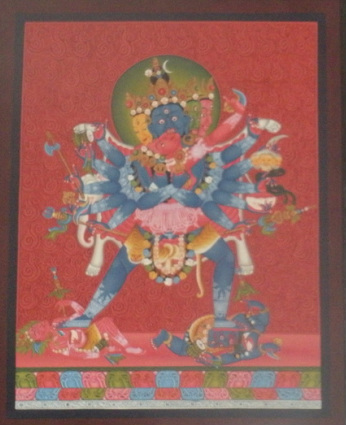
One of my favorite examples of meditational art is of the wrathful Buddhist deity, Chakrasamvara and his consort Vajravahar. The deities are part of the highest yoga tantric traditions.
Chakrasamvara tantra is frequently painted as a visual tool for transformative meditative practices according to Professor John C. Huntington in The Circle of Bliss: Buddhist Meditational Art.
Although it’s not feasible for me to go into depth about the iconography of Chakrasamvara within the scope of this blog, here is a cursory study of this visual tool used for meditation.
The 2 figures are surrounded by a sacred orange fire in an eternal embrace with Vajravahar’s legs tightly wrapped around Chakrasamvara’s waist in sexual union. The joining of the female and male entities is intended to show the blissful yoking of compassion and wisdom. Chakrasamvara’s right foot stands atop Kalaratri, the slayer of evil spirits. Crushed under his left foot is Bhairava who represents samsara or the repeated cycles of birth, misery, and death. A garland of 50 human heads hangs from his body depicting dozens of emotional barriers obliterated on the path to nirvana.
The four-headed, twelve-armed Chakrasamvara holds a specific object in each hand signifying an implement used in reaching spiritual truth and triumphing over obstacles to enlightenment.
Right hands:
1) The ghanta or bell for the divine primordial sound used to chase away demons.
2) The left-front foot of the elephant hide illustrating the end of delusions and ignorance.
3) The damaru, an hourglass-shaped drum typifying the sound that began and sustains the universe.
4) The vajra chopper or kartri cleaving away defects such as anger, envy, greed, pride, and ignorance.
5) The ax for cutting off birth and death at the roots.
6) The trident standing for the destruction of ignorance, desire, and aggression.
Left hands:
1) The vajra (thunderbolt) for the destruction of the ego.
2) The left-back foot of the blood-stained elephant hide embodying the cloak of ignorance.
3) The severed four-faced head of Brahma denoting victory over the temptation to become a god.
4) The vajra lasso binding beings to wisdom from life to life.
5) The skull cup filled with blood suggesting any discrimination towards existence and nonexistence has been detached.
6) The khatvanga staff indicative of the blissful thought of enlightenment.
Continued meditation on Chakrasamvara aids in overcoming the specific obstructions fixed in a self-centered consciousness to achieve the ultimate liberation from the desire manifested by this individual consciousness.
Additional resources: Yoga, Power, and Spirit
Follow us on Facebook and Twitter. For yoga in Dunellen, NJ or yoga in Piscataway, NJ and yoga in other Central New Jersey areas, get in touch with me at Yoga Destiny.
Chakrasamvara tantra is frequently painted as a visual tool for transformative meditative practices according to Professor John C. Huntington in The Circle of Bliss: Buddhist Meditational Art.
Although it’s not feasible for me to go into depth about the iconography of Chakrasamvara within the scope of this blog, here is a cursory study of this visual tool used for meditation.
The 2 figures are surrounded by a sacred orange fire in an eternal embrace with Vajravahar’s legs tightly wrapped around Chakrasamvara’s waist in sexual union. The joining of the female and male entities is intended to show the blissful yoking of compassion and wisdom. Chakrasamvara’s right foot stands atop Kalaratri, the slayer of evil spirits. Crushed under his left foot is Bhairava who represents samsara or the repeated cycles of birth, misery, and death. A garland of 50 human heads hangs from his body depicting dozens of emotional barriers obliterated on the path to nirvana.
The four-headed, twelve-armed Chakrasamvara holds a specific object in each hand signifying an implement used in reaching spiritual truth and triumphing over obstacles to enlightenment.
Right hands:
1) The ghanta or bell for the divine primordial sound used to chase away demons.
2) The left-front foot of the elephant hide illustrating the end of delusions and ignorance.
3) The damaru, an hourglass-shaped drum typifying the sound that began and sustains the universe.
4) The vajra chopper or kartri cleaving away defects such as anger, envy, greed, pride, and ignorance.
5) The ax for cutting off birth and death at the roots.
6) The trident standing for the destruction of ignorance, desire, and aggression.
Left hands:
1) The vajra (thunderbolt) for the destruction of the ego.
2) The left-back foot of the blood-stained elephant hide embodying the cloak of ignorance.
3) The severed four-faced head of Brahma denoting victory over the temptation to become a god.
4) The vajra lasso binding beings to wisdom from life to life.
5) The skull cup filled with blood suggesting any discrimination towards existence and nonexistence has been detached.
6) The khatvanga staff indicative of the blissful thought of enlightenment.
Continued meditation on Chakrasamvara aids in overcoming the specific obstructions fixed in a self-centered consciousness to achieve the ultimate liberation from the desire manifested by this individual consciousness.
Additional resources: Yoga, Power, and Spirit
Follow us on Facebook and Twitter. For yoga in Dunellen, NJ or yoga in Piscataway, NJ and yoga in other Central New Jersey areas, get in touch with me at Yoga Destiny.

